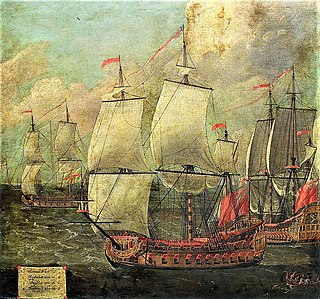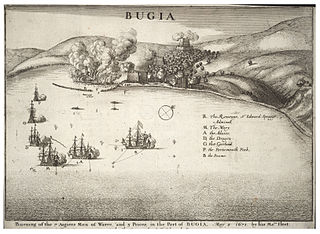HMS Antelope was a 50-gun fourth rate ship of the line of the Royal Navy, launched at Rotherhithe on 13 March 1703. She was rebuilt once during her career, and served in the Seven Years' War and the American Revolutionary War.

HMS Assurance was a 32-gun fourth-rate of the English Navy, built by Peter Pett I at Deptford Dockyard and launched in 1646. She was in the Parliamentary force during the English Civil War, then the Commonwealth Navy and was incorporated into the Royal Navy after the Restoration in 1660. During her time in the Commonwealth Navy she partook in the Battles of Dover, Portland, Gabbard and Texel. She foundered in a gale at Woolwich in 1660 and was salved. After the Restoration she partook in the Battle of Lowestoffe, the Four Days Fight and the Texel (1673). She was reduced to a Fifth Rate in 1690 before being sold in 1698.
The English ship Speaker was a 50-gun third-rate. Speaker was built for the navy of the Commonwealth of England by Christopher Pett at Woolwich Dockyard and launched in 1650. At the Restoration she was renamed HMS Mary. She was the prototype of the Speaker-class.

Fairfax was a third rate frigate of the navy of the Commonwealth of England from 1653 to 1660. With the restoration of the English monarchy in 1660 she was recommissioned as HMS Fairfax and served with the Royal Navy until 1674.
The Worcester was a 48-gun Third rate frigate built for the navy of the Commonwealth of England at Woolwich Dockyard by Master Shipwright Andrew Burrell and was launched in 1651). She was named for the Parliamentary victory at the Battle of Worcester.

President was a 38-gun fourth rate frigate of the Royal Navy, originally built for the navy of the Commonwealth of England by Peter Pett I at Deptford Dockyard, and launched in 1650.

Advice was one of six 40-gun fourth-rate frigates, built for the Commonwealth of England under the 1650 Programme, she would be transferred to the navy of the Kingdom of England upon the Restoration of the monarchy in May 1660. During her time with the Commonwealth Navy she would fight in two major fleet engagements of the First Anglo-Dutch War, this being the Battle of Portland and the Battle of the Gabbard. After the Restoration she would be involved in the Second Anglo-Dutch War specifically the Battle of Lowestoft and the St James Day Battle. She would also be present at the attack on the Vile or better known as Holmes Bonfire. She would see action against the Algerines at the Battle of Bugia. During the Third Anglo-Dutch War she would do battle at the Battle of Solebay, The Battle of Schooneveld and the Battle of Texel. She would also do battle against the French at the Battle of Bantry Bay. She would see service in both the West and East Indies before being rebuilt at Woolwich.
The Pelican was one of six 40-gun fourth-rate frigates, built for the Commonwealth of England under the 1650 Programme. After commissioning she partook in the First Anglo-Dutch War being present at the Battles of Kentish Knock, Portland, the Gabbard and Scheveningen. She was accidentally burnt at Portsmouth in early 1656.
HMS Assistance was one of six 40-gun fourth-rate frigates, built for the Commonwealth of England under the 1650 Programme, after the Restoration of the monarchy in 1660 she was incorporated into the navy of the Kingdom of England. During her time in the Commonwealth Navy she partook in the First Anglo-Dutch War being present in the battles of Kentish Knock, Portland and The Gabbard. In the Mediterranean she was present at the Battle of Santa Cruz and the bombardment of Porto Farina, In the Second Anglo-Dutch War she was involved in the Battle of Lowestoft, Battle of Vagen and the St James Day Fight. She did not participate in fleet actions after this. She spent the rest of her service life undergoing several rebuilds and plying the waters as a cruiser protecting British trade and projecting British sovereignty. After nearly 95 years of Service she was sunk as a break water at Sheerness at the end of 1745.
Gainsborough was a 40-gun fourth-rate frigate of the English Navy, originally built under the 1652 programme for the navy of the Commonwealth of England by Thomas Taylor at Pitch House (Wapping), and launched in 1653. She was named for the Parliamentarian victory at the Battle of Gainsborough in 1643.
Diamond was a 40-gun fourth-rate frigate of the English Royal Navy, originally built for the navy of the Commonwealth of England by Peter Pett at Deptford Dockyard, and launched on 15 March 1652. By 1677 her armament had been increased to 48 guns.
The English ship Kentish was a 40-gun fourth-rate frigate of the Commonwealth of England Navy, built by contract at Deptford and launched in November 1652.
The Sussex was a fourth-rate frigate, built for the navy of the Commonwealth of England at one of the national Dockyards, and launched in late 1652. Her place of building is uncertain, with certain sources recording this as Portsmouth, others as Deptford and still others as Woolwich. A standard practice at this time was to build the hull in one location and masts and superstucture could be at a separate dock, and the fitting of equipment at a third location.
Yarmouth was a 44-gun fourth-rate frigate of the English Royal Navy, originally built for the navy of the Commonwealth of England at Great Yarmouth under the 1652 Programme, and launched in 1653. By 1666 her original armament of 44 guns had been increased to 52 guns by the addition of smaller cannon (sakers) on the quarterdeck, and by 1677 she carried 54 guns.

HMS Dartmouth was a 50-gun fourth-rate ship of the line of the Royal Navy, one of eight such ships authorised by the Navy Board on 24 December 1695 to be newly built ; the others were the Hampshire, Winchester, Salisbury, Worcester, Jersey, Carlisle and Tilbury. The contract for the Dartmouth was signed in 1696 with shipbuilder James Parker, for the ship to be built in his site in Southampton, taking the name of the previous Dartmouth of 1693, and she was launched there on 3 March 1698.
HMS Rochester was a 50-gun fourth rate ship of the line of the Royal Navy, and the fifth such ship to be ordered in 1692. She was launched at Chatham Dockyard on 15 March 1693.

HMS Guernsey was a 50-gun fourth rate ship of the line of the Royal Navy, one of four ordered in September 1694 to be built by commercial contracts; eight further ships of this type were ordered on 24 December. The Guernsey was built by Sir Henry Johnson's Blackwall Yard and launched on 6 July 1696.
HMS Warwick was a 50-gun fourth rate ship of the line of the Royal Navy, one of four ordered in September 1694 to be built by commercial contracts; eight further ships of this type were ordered on 24 December. The Warwick was built by Robert and John Castle at their Deptford shipyard and launched on 20 August 1696.
Convertine was a 36-gun fourth rate vessel captured from the Portuguese by the Commonwealth of England. She was commissioned into the Parliamentary Naval Force as Convertine. During the First Anglo-Dutch War she partook in the Battle of Dungeness, Battle of Portland and the Battle of the Gabbard. During the Second Anglo-Dutch War she participated in the Battle of Lowestoft and the Four Days' Battle. She was captured during the Four Days' Battle.




